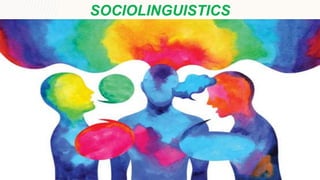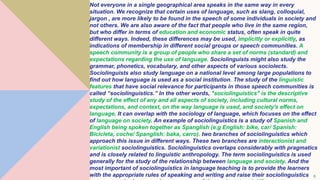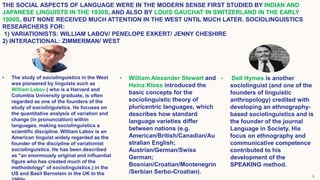This document provides an overview of key concepts in sociolinguistics. It discusses how sociolinguistics examines language variation according to social factors like age, gender, education level, occupation, and social class. Some key findings are:
1) Social dialects vary regionally and according to social class. Working class speakers tend to use features that differ from middle class speakers, marking social status.
2) Social markers like pronunciation patterns (e.g. dropping /r/ sounds) can signify membership in social groups. Features associated with less education often indicate lower class.
3) Basil Bernstein identified "elaborated codes" used by middle/upper classes that emphasize individual expression, and "restricted codes












![Social dialects
The study of social dialects has been mainly concerned with speakers in towns
and cities (rural and urban areas) . A commonly studied source of variation is
regional dialects. Dialectology studies variations in language based primarily on
geographic distribution and their associated features. Sociolinguists concerned
with grammatical and phonological features that correspond to regional areas are
often called dialectologists. In the social study of dialect, it is social class that is
mainly used to define groups of speakers as having something in common. The
two main groups are generally identified as “middle class,” those who have more
years of education and perform non-manual work, and “working-class,” those who
have fewer years of education and perform manual work of some kind. So, when
we refer to “working-class speech,” we are talking about a social dialect. The terms
“upper” and “lower” are used to subdivide the groups, mainly on an economic
basis, making “upper-middle-class speech” another type of social dialect or
sociolect. These features of social dialects are pronunciations, words or structures
that are regularly used in one form by working-class speakers and in another form
by middle-class speakers. In Edinburgh, Scotland, for example, the word (home) is
regularly pronounced as [heɪm], as if rhyming with fame, among lowerworking-
class speakers, and as [hom], as if rhyming with foam, among middle-class
speakers. It’s a small difference in pronunciation, but it’s an indicator of social
status. When we look for other examples of language use that might be
characteristic of a social dialect, we treat class as the social variable and the
pronunciation or word as the linguistic variable.We can then investigate any
systematic variation in usage by counting how often speakers in each class use
each version of the linguistic variable. This is rarely an all-or-nothing situation, so
13](https://image.slidesharecdn.com/sociolinguistics-240201003101-be3c171f/85/sociolinguistics-pptx-13-320.jpg)



![Social markers
As we shown, the significance of the linguistic variable (r) can be virtually the opposite in terms of
social status in two different places, yet in both places the patterns illustrate how the use of this
particular speech sound functions as a social marker. That is, having this feature occur frequently in
your speech (or not) marks you as a member of a particular social group, whether you realize it or not.
There are other pronunciation features that function as social markers. One feature that seems to be a
fairly stable indication of lower class and less education, throughout the English-speaking world, is
the final pronunciation of -ing with [n] rather than [ŋ] at the end of words such as sitting and thinking.
Pronunciations represented by sittin’ and thinkin’ are typically associated with working-class speech.
Another social marker is called “[h]-dropping,” which makes the words at and hat sound the same. It
occurs at the beginning of words and can result in utterances that sound like I’m so ’ungry I could eat
an ’orse. In contemporary English, this feature is associated with lower class and less education. It
seems to have had a similar association as a social marker for Charles Dickens, writing in the middle
of the nineteenth century. He used it as a way of indicating that the character Uriah Heep, in the novel
David Copperfield, was from a lower class, as in this example (from Mugglestone, 1995).
“I am well aware that I am the umblest person going,” said Uriah Heep, modestly;
“ ... My mother is likewise a very umble person. We live in a numble abode, Master Copperfield, but we
have much to be thankful for. My father’s former calling was umble.”
So, Sociolinguistics as a field distinct from dialectology was pioneered through the study of language
variation in urban areas. Whereas dialectology studies the geographic distribution of language
variation, sociolinguistics focuses on other sources of variation, among them class. Class and
occupation are among the most important linguistic markers found in society. One of the fundamental
findings of sociolinguistics, which has been hard to disprove, is that class and language variety are
related. Members of the working class tend to speak less of what is deemed l standard language, while
the lower, middle, and upper middle class will, in turn, speak closer to the standard. However, the
upper class, even members of the upper middle class, may often speak 'less' standard than the middle
class. This is because not only class but class aspirations, are important. One may speak differently
or cover up an undesirable accent to appear to have a different social status and fit in better with
either those around them, or how they wish to be perceived. 17](https://image.slidesharecdn.com/sociolinguistics-240201003101-be3c171f/85/sociolinguistics-pptx-17-320.jpg)














![Vernacular language
The form of AAE that has been most studied is usually described as African American
Vernacular English (AAVE). The term “vernacular” has been used since the Middle Ages,
first to describe early local versions of the European languages that eventually became
French, Italian and Spanish (low prestige) in contrast to Latin (high prestige), then to
characterize any non-standard spoken version of a language used by lower status
groups. So, the vernacular is a general expression for a kind of social dialect, typically
spoken by a lower-status group, which is treated as “nonstandard” because of marked
differences from the “standard” language. (See Chapter 18 for more on the concept of
the standard language.). As the vernacular language of African Americans, AAVE shares
a number of features with other non-standard varieties, such as “Chicano English,”
spoken in some Hispanic American communities. Varieties of what has been called
“Asian American English” are also characterized by some of the pronunciation features
described in studies of this vernacular.
The sounds of a vernacular
A pervasive phonological feature in AAVE and other English vernaculars is the tendency
to reduce final consonant clusters, so that words ending in two consonants (left hand)
are often pronounced as if there is only one (lef han). This can affect the pronunciation
of past tense -ed forms in certain contexts, with expressions such as iced tea and I
passed the test sounding like ice tea and I pass the tess. This characteristic is shared
with many pidgins and creoles, as described in Chapter 18, and has led to the
suggestion that AAVE may have initially come into being in a way similar to other
English creoles. Initial dental consonants (think, that) are frequently pronounced as
alveolar stops (tink, dat), with the result that the definite article (the) is heard as [də], as
in You da man!. Other morphological features, such as possessive -’s (John’s girlfriend)
and third person singular -s (she loves him), are not typically used (John girlfriend, she32](https://image.slidesharecdn.com/sociolinguistics-240201003101-be3c171f/85/sociolinguistics-pptx-32-320.jpg)

